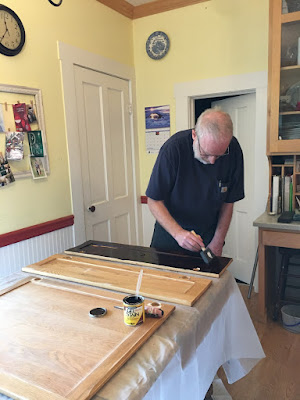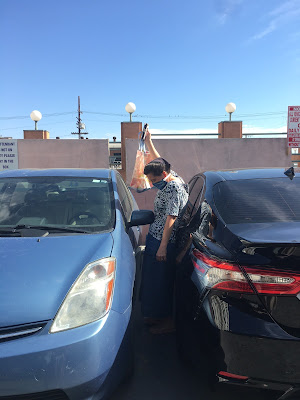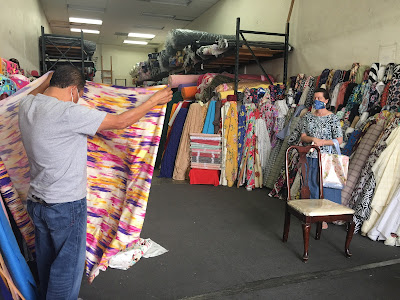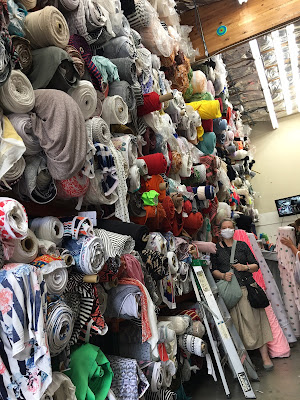Probably fifteen people have asked Aunt Dorcas to write a parenting book. She keeps saying "No, I don't think so," but she got going on this post and admits that this is almost book-length. She doesn't want you to feel any obligation to read it all.
 |
| Aunt Dorcas in San Diego |
Dear Aunt Dorcas,I read your article on parenting and while I mostly agree, it gives me unpleasant images of peers of mine, shrugging weakly while their belligerent children boldly defy them, unhindered. Can you round out your last article with some helpful viewpoints or include some direction regarding this?
You said that so much of what parents react to is simply children being children. Agreed. But to what extent? I realize that much of that is for the parent to discern. Could you help us? I’ve read enough of your writings to know your not on level with the mom that smiled wanly at her son as he hammered on mine, explaining that he was tired. Or explaining during utter mutiny about their house, that knowing the family needed to move in a month was ‘wearing on them and feeling that they didn’t have their own space’.
I know, there’s always context. Probably I’ve been unjust in my conclusions. However, it doesn’t take long in my household for me to see that my children have an uncanny ability to capitalize on excuses I make for them. I don’t want to be like the suit-coated, pinching father you mentioned or the weak willed woman I mentioned. Please help us stay out of ditches. A lot of people I know read your writings and are greatly influenced- I appreciate that and I’m asking for more influence on this regard.
--Sherri
Dear Sherri--
Here’s a summary of raising children, in case you don't have time to read the whole post:
1. Children need guidance and involvement to become functional adults.
2. This is a lot of work.
3. If you’re the mom or dad, it’s your job to do the parenting.
4. You have to be the grownup.
5. You have what it takes.
What is the opposite of a dog?
As the principal’s wife for over 30 years, I gave the ACE Reading Readiness Test to lots of little preschoolers.
One task involved finding opposites, and it featured a picture of a dog. All right, little Braxton, what is the opposite of a dog? Two of the options were things like a tree and a cup. The third was a cat. That was the “right” answer. The child was supposed to circle the picture of the cat.
I would tell the kids to skip that one because, let’s be clear, a cat is not the opposite of a dog. They are two different kinds of domesticated mammals.
A surprising number of people wrote to me after my post on March 21, concerned that if I was speaking out against spank-to-break-the-will parenting, then I was promoting its “opposite,” lax and lazy parenting.
As with cats and dogs, harsh parenting and lax parenting are not opposites. They are two different kinds of bad parenting. Both choose the parent’s convenience over actually teaching the child.
The opposite of both is strong, committed, active, involved, loving parenting.
I understand the concern, though. Most of us don’t witness the sort of abusive parents who traffic their kids or the neglectful parents who essentially hire someone to raise their kids for them. Many of us, praise God, don’t witness will-breaking parenting either.
But we all see inadequate parenting, where parents seem helpless before their children. I'll focus more on the aggressive child in this post, but this also applies to the parent who acts helpless before defiance and chaos.
So what does this lax parenting look like?
I mentioned in my previous post that often a child needs food or sleep rather than another lecture or a spanking, because he is a child, and this is what children do. A number of people took issue with that and felt I was promoting the sort of parenting that accepts any kind of behavior because the child is a child.
We’ve all been there. This is the mom who sips her coffee while her son attacks yours with a pair of scissors. As you levitate from your chair in horrified wrath, the other mom laughs. “Oh, calm down. He’s fine. They’ll figure it out on their own. Kids will be kids.”
Um, yeah. That’s the problem. This is what kids do, and your job is to teach them not to. My son is about to lose an eyeball, you think.
The will-breaking mom is likely to snatch up her toddler, haul him into the next room, and give him 25 smacks you can hear from where you’re sitting. That’s not helpful either.
In many years of parenting and observing, this is what I’ve found: The overly-spanked child and the un-parented child are equally likely to hit your child over the head with the Fisher-Price telephone. The only difference is, the will-broken child will wait until his mom isn’t looking.
Despite appearances, these methods are the same sort of neglect. They fail to teach the child basic life skills of empathy, manners, kindness, respect, and boundaries.
The aggressive child has a lot to lose when, as he gets older, no one likes him or wants to play with him. He won’t understand why, or how to change things.
Sternly parented kids are often dishonest, manipulative, and devious.
Unparented kids are often aggressive, selfish, and destructive.
A good mom, in this case, will get involved. She won’t let other kids suffer at her child’s hands. Ideally, she’ll take away the scissors or toy, make sure the other child is ok, and instruct her child on what to do and not do.
If her kid is tired, thirsty, or hungry, she’ll make sure that need is met. If he can’t handle playing with other kids, she’ll take him out of the situation.
This—sorry to break it to you—involves actually doing something.
I know it’s hard. You are lonely and exhausted as a full-time mom, and you finally get to spend time with a few friends. There you are, around the table, sipping coffee while the kids play, and at long long last you get to talk with other adults. Someone asks you what was the deal with Joe and Martha—they’ve been hearing rumors--and everyone turns and looks at you.
Oh my word. You have been living for this moment. All eyes on you, no one interrupting, and you’re holding the juiciest gossip in your hand, like a ripe plum. You lean forward. “Well! So Joe was doing some concrete work for my husband last week, on that new storage building, and they got to talking, and oh, goodness, I hope it’s ok for me to share this. He said they need to make a trip to Wisconsin next week…”
“WAAAAAHHHHHH!!”
You all turn around. Your toddler is whacking Sandra’s with a heavy little John Deere tractor.
This is the crucial parenting moment.
I am so sorry to tell you this, but here we go: This is your child, acting like a child. But you can’t let him continue this behavior. You have to be the grownup. You have to stop your story, raise your weary self from the chair, walk across the room, settle the fight, make sure the other kid is ok, and figure out how to make sure it doesn’t happen again.
By the time you get back, Sandra with her loud voice will have taken the opportunity to start in on vaccines, and how you know there’s that misguided neighboring church where they all give their kids shots, and when you visit there and the children turn around and stare at you in church, it seems like they all have kind of a blank stare, with those odd close-set eyes and pointed noses? WELL! there’s a new study out showing that a whole generation of children is looking suspiciously like chickens, because they culture the MMR vaccine in egg whites!*
*I made that up.
Everyone will gasp. The conversation will go from vaccines on to Kathy’s kids getting the flu to the Christmas program at school. You won’t get back to your story until you’re about to go home, and your children are crying, and the hostess says, Oh yeah, what was that you were saying, about Joe and Martha?
Arrrrggghhh.
But you are the grownup, and you will do the necessary thing for the sake of your child.
Children are naturally adorable but utterly ignorant and uncivilized. They aren’t born knowing the rules. Unless taught otherwise, they will touch all the cupcakes on the plate before choosing one, steal from the convenience store, and paint graffiti on bridges.
Children don’t naturally trim their fingernails, take turns, cover their mouth to cough, or eat with a fork. They have to be taught to finish a task, tell the truth, and say thank you.
They might pick up some of these life lessons from watching other people or from teachers and aunts, but it would be a big favor to all of us if you, the parents, would tie your apron and take on this job.
This is your child. It is your job to teach them. Yes, it’s a big job and you don’t feel up to it. Do it anyhow.
It’s not about punishing them every time they turn around or excusing bad behavior. It’s about carefully cultivating a relationship, meeting their needs, getting to know them as people, coaching, guiding, and teaching them the life skills they need to make it on their own.
Remember the story of the dad pinching the little girl in church because she played with her braids? The kids in that family could sit like statues in church. But. Two of the children attended the school where I taught. At all-school assemblies, those two were the worst behaved of anyone. Moving, talking, turning, distracting. The dad’s tight control wasn’t teaching them anything except to sit still in his presence. Away from him, they didn’t know how to be quiet and respectful, or why.
A better method would have been to sit on the couch at home and practice sitting still for half an hour while Dad reads a Bible story. It could be fun, with lots of praise for learning this self-discipline, and instructive--we sit still so others can worship. "You guys are amazing. Have some M&Ms."
Parenting involves finding the delicate balance between individualism and collectivism.
Your child is a unique individual. You need to get to know him or her, understand them, give them grace to be kids, and encourage their gifts.
But they are also part of a big world full of people. Their actions will almost always affect others. It’s crucial that they learn to value others, respect boundaries, practice kindness, and treat others like they want to be treated, both at home and away.
It’s your job to make sure your child doesn’t hurt other people, destroy their possessions, or generally create misery wherever they go.
I met a nice Christian mom who told a group of us how her little boy won’t have a bowel movement unless he takes all his clothes off first. Then he sits on the toilet for twenty minutes, swinging his feet and talking to himself. So, if they’re shopping and he has to poop, she grabs a magazine and takes him into the handicapped stall for this lengthy process. All the clothes come off, he sits there doing his business, and she sits on the floor in front of him and reads her magazine. If someone comes in and wants to use the stall, she shrugs and says, “Sorry.”
She laughed. I didn’t.
This story bothered me for these reasons:
1. The mom takes no initiative to improve this situation. She is helpless before the child’s preferences.
2. She takes up the handicapped stall for this operation. Her son learns that his wishes are important enough to supersede the needs of a disabled person in their designated stall, no less.
3. I’m afraid she puts that magazine back on the rack after she’s been reading it on the bathroom floor.
The main thing that needs to happen here is not a big discipline session with the child. The problem is the mom. She’s not being the grownup. She’s not caring how her and her son’s behavior affects other people.
So that comes first. They need to use the smaller stall, even if it’s cramped.
And she needs to bring her own reading material.
Then she needs to realize that she isn’t without capacity and volition. If she enjoys the break from shopping, fine. She could also practice changing the routine at home. "This week you’re going to be a big boy and leave your shirt on when you poop." The next week, he gets a reward if he finishes in under 15 minutes.
Even if the child genuinely needs his 20 minutes, they can meet that need but still be considerate.
The mom and dad are the adults. They need to figure it out. The more aware they are of how their own behavior affects others, the easier it will be to teach the child to be considerate.
All of our six children have lived at home for at least part of their college years. One of the many advantages of this is that I get to hear their stories about other students.
College is often the first time that kids are on their own and away from home, making their way as adults. I’ve determined that it’s a JumboTron screen where their parents’ parenting is displayed in living color.
Some have obviously learned to work hard, get along with people, make good decisions, plan ahead, behave graciously, communicate, and take social cues.
Others have not.
Jenny, a senior at Oregon State, has been going off recently about a classmate we’ll call Jordan. “He is SO full of himself and acts like he knows EVERYTHING. He goes off about RINGS! You don’t talk about RINGS* in an advanced calculus class! And he sits there and picks his nose and eats it RIGHT in my line of sight! We were supposed to read this article and share something we’d learned, and he spoke up right away and said, ‘Oh, I knew all that information already,’ so it made everyone else feel stupid, but then I spoke up anyway and shared something I’d learned, then I think that made other people feel ok about talking too.”
*a complicated math concept, not a band around your finger
Jordan might be autistic, I’ll grant that. But a more likely guess is that he was taught to value his own conclusions but not to interact graciously in a group. So he gets to live with being disliked in all his classes but probably never knowing why.
The most specific test for how people were parented is college group projects.
It might be a class on English literature, fluid dynamics, or teaching reading. The professor, feeling vindictive toward the world, decides to divide everyone into groups of four. Each group needs to work together to research a situation and write a summary.
Group projects can be helpful and interesting when everyone contributes. They can be torture when they don’t, and I’ve had grownup kids in tears over group projects.
I asked Emily what kinds of people are the worst to work with. She said, “Most people do ok, actually. But others don’t communicate. They don’t pull their weight. Or there are people who are SO CONFIDENT that their way is the right way and are completely unwilling to give an inch.”
Your goal is to raise a child to be welcome in group projects in college, construction crews, youth groups, and church committees.
You don’t have to whip your child into abject submission, let them terrorize the other toddlers because kids will be kids, or any number of bad ways to parent.
You do, however, need to be a healthy and whole person yourself. You need to pursue inner health and Jesus, and parent out of that good place.
Then, you need to invest yourself deeply into this precious little life and be the loving adult, guiding and leading.
God gave you this child. He’ll give you what it takes.
You are the adult. You can do this. It will be worth it.
That’s what I think.
--Aunt Dorcas













































